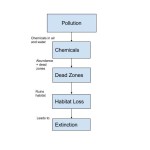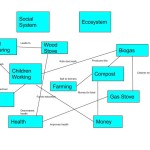1) Create a system diagram defining one of the elements of H.I.P.P.O.
2) In 150-250 words describe the key ideas of your diagram.
In my diagram, I used the element of pollution out of the H.I.P.P.O. concept. Pollution is putting chemicals, such as nitrogen and phosphorous, into the air or water of an ecosystem. An abundance of chemicals in any ecosystem can to bad consequences. One example of this is “dead zones”. Dead Zones are places in an ecosystem that can no longer sustain life. This happens when the area becomes overrun with chemicals that are not naturally occurring there. These dead zones can ruin complete habitats. An abundance of these dead zones create habitat loss for different animals. The animals have to now search for new habitats, which put extreme stress on other habitat’s resources. This stress can lead to animal extinction. If there are too many animals competing for the same resources, some are not going to survive and could eventually lead to the entire species being wiped out. Pollution can lead to a chain reaction of events that drastically change the animal landscape.
3) In 150-250 words, what threats to biodiversity are in your hometown?
Habitat Loss is one threat that my hometown of Greensburg, Pennsylvania is currently facing. There are new buildings going up in and around the surrounding area of the town. In order to build these new buildings, habitats are being destroyed. They are being destroyed mostly by deforestation. One animal that depends on these forests are the whitetail deer. Their habitats continue to shrink and shrink in order for new homes to be built on the property. They are being pushed and pushed into smaller areas of habitat that cannot sustain their numbers. The habitat and the deer suffer from this new change. Biodiversity cannot be sustained in little small pockets throughout the town, but that is what is currently trending towards. One way to prevent this is to demolish or remodel current abandoned buildings instead of creating new ones. It will help to prevent any more loss of habitat to keep our town as bio diverse as possible.




